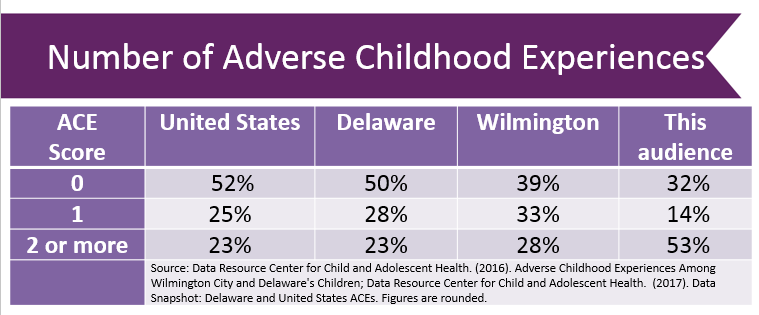Resilience Film Screening: Recap
Last week, about 100 people gathered in Theatre N for a screening of the film “Resilience: The Biology of Stress and the Science of Hope” and panel discussion among local experts. If you weren’t one of the lucky 100, here’s a summary of the event, themes from the conversation, and ways to get involved.
 Why Resilience?
Why Resilience?
“Resilience” is a documentary by KPJR (the makers of “Paper Tigers”) that chronicles the birth of a new movement among pediatricians, therapists, educators, and communities, to delve into the science behind Adverse Childhood Experiences (ACEs) and using cutting-edge brain science to disrupt cycles of violence, addiction, and disease that cause toxic stress.
As we described in a previous blog post, Adverse Childhood Experiences are not an “over there” problem—ACEs are shockingly prevalent, in Delaware and around the country, and with children of all backgrounds. Attendees at the screening voluntarily and confidentially submitted their ACEs score. The tallied results affirmed this. 53% of attendees reported an ACE score of two or more.
A major theme of “Resilience” is just how prevalent trauma is—and that greater public awareness of these issues could lead to a shift in how we address them. If a young person experiencing trauma knew that other classmates experienced something similar—would that make it less scary? Would he feel more empowered to seek help? As better trauma-informed community members, might we start asking the question “what happened to you?” instead of “what’s wrong with you?” when dealing with at-risk youth?
How do you build resilience?
The film identified that healthy, positive relationships are the number one source of resilience. A report by Casey Family Programs, Balancing Adverse Child Experiences (ACEs) With HOPE: New Insights into the Role of Positive Experience on Child and Family Development elaborates on this point and urges a balance of trauma-informed policies and HOPE-informed measures.
The report summarizes research studies showing that the negative impact of adversity on childhood development can be remedied through:
- Nurturing and supportive relationships
- Safe, stable, protective, and equitable environments to develop, play, and learn
- Constructive social engagement and connectedness
- Social and emotional competencies
The HOPE model (The Health Outcomes of Positive Experiences), pictured below, takes an asset-based approach.
Additionally, attendees were given the Resilience screener which helps identify protective factors and positive experiences that can increase one’s ability to handle adversity.
How can we make this happen in Delaware?
Following the film, three panelists fielded questions and comments from the audience:
- Aileen Fink, PhD | Director of Trauma-Informed Care, Delaware Children’s Department
- Meghan M. Lines, PhD | Clinical Director, Nemours A.I. duPont Hospital for Children
- Teri Lawler | School Psychologist, Stanton Middle School, Red Clay School District
And a few themes emerged from the conversation:
- Resilience is learned: We are not born with the ability to overcome stress. It must be intentionally modeled and developed. In schools, there needs to be a common language for integrating social and emotional learning alongside academic learning.
- Positive relationships are key. This includes a primary care doctor, educators, parents, grandparents, and others.
- Parental involvement is essential: Support positive parenting practices with multi-generational, evidence-based approaches (such as home visiting) to build social, emotional, and executive functioning skills.
- Meet students (and families) where they are: Listening is a crucial first step, rather than assuming. Children and families need to be engaged in their own social and emotional development, and interventions or services need to be tailored to their unique needs.
- Recognize where data-driven decision-making is needed: Enable innovative interventions, keep track of what’s working for kids, and adjust or abandon strategies accordingly.
- Coordinate services: Schools can be a hub for services, but educators can’t be expected to do it alone.
- Siloes exists: One of the challenges will be coordinating and communicating across health, education, government, community, etc. Additionally, political will and availability of funding are challenges but not excuses.
- ACES are a public health concern, and awareness building is needed. For instance, ongoing professional development for educators starting in pre-service is needed to first build awareness, and then build skills.
What’s next?
- Encourage your colleagues to learn their ACEs or Resilience
- Read more about Adverse Childhood Experiences Among Wilmington City & Delaware’s Children.
- Share your thoughts! Tweet your responses to the following questions using #SELinDE.
- What are you doing to build resilience?
- What resilience initiatives are already underway in Delaware?
- What else is needed to help overcome the effects of adverse childhood experiences?
- How can we do to build on what’s working?
- Visit http://bit.ly/RodelSEL to find additional information on national and state level data and initiatives related to Social and Emotional Learning.
- Be on the lookout for the Vision Coalition of Delaware’s 10th Annual Conference on October 30th where community members will converge in Newark to explore the intersection of education and healthy communities.



